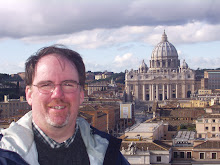 The Church, since it is a living organism (the Body of Christ) continually evolves. This is sometimes most noticeable in the celebrations of the liturgical year. We sometimes forget that the Holy Spirit left no liturgical calendar with the Apostles on that First Pentecost!
The Church, since it is a living organism (the Body of Christ) continually evolves. This is sometimes most noticeable in the celebrations of the liturgical year. We sometimes forget that the Holy Spirit left no liturgical calendar with the Apostles on that First Pentecost!Prior to the fourth century, Sunday was the primary feast in the Church. A yearly commemoration of the Pasch (Easter) was celebrated from an early time and from that came related liturgical days (Palm Sunday, Holy Thursday, Good Friday leading to the Easter Vigil, for example).
The origins of the Christmas feast are not entirely clear. According to Adolf Adam's book, The Liturgical Year, there is concrete evidence that the celebration of the birth of Christ was occurring on December 25 in Rome in 336.
But scholars are divided as to the reason for the selection of December 25 for this feast. Some believe it was to "baptize" a pagan festival of "the Unconquered Sun-God" to the the Syrian sun-god Emesa established throughout the Roman Empire in 274 (to be celebrated each year on December 25, the day of the winter solstice). After all, Jesus Christ is the Sun of Righteousness, the Light of the World, never to be conquered.
Other scholars believe that third-century Christians wished to calculate the exact date of Jesus' birth.
The Christ-as-sun symbolism that was so deep-rooted in the Christian consciousness caused them to pay special attention to the equinoxes and solstices. One opinion was that John the Baptist was conceived at the autumn equinox and born at the summer solstice. But since according to Luke 1:26 Christ was conceived six months after John, he was conceived at the spring equinox (March 25) and was therefore born on December 25. (Adolf Adam, The Liturgical Year, p. 123)
Regardless of how or why, the date of December 25th took root in the west. In the fourth century the Church was neither as centralized as it is today nor did it have the ability to communicate quickly. Still, this feast spread rapidly even to those places in the east that celebrated January 6 as the date of the manifestation of God in flesh. In fact, many calendars had both celebrations.
Today in the western Church December 25th marks the date of Christ's birth into the world. God put on human flesh and became like us in all things but sin. In the west January 6 (Epiphany) celebrates the revelation of God in Christ to all the nations.
Midnight Mass also has ancient roots, dating back to the fifth century when the pope would celebrate Mass in a chapel (designed to be a replica of the cave of Christ's birth in Bethlehem) deep beneath the basilica of Saint Mary Major.

No comments:
Post a Comment